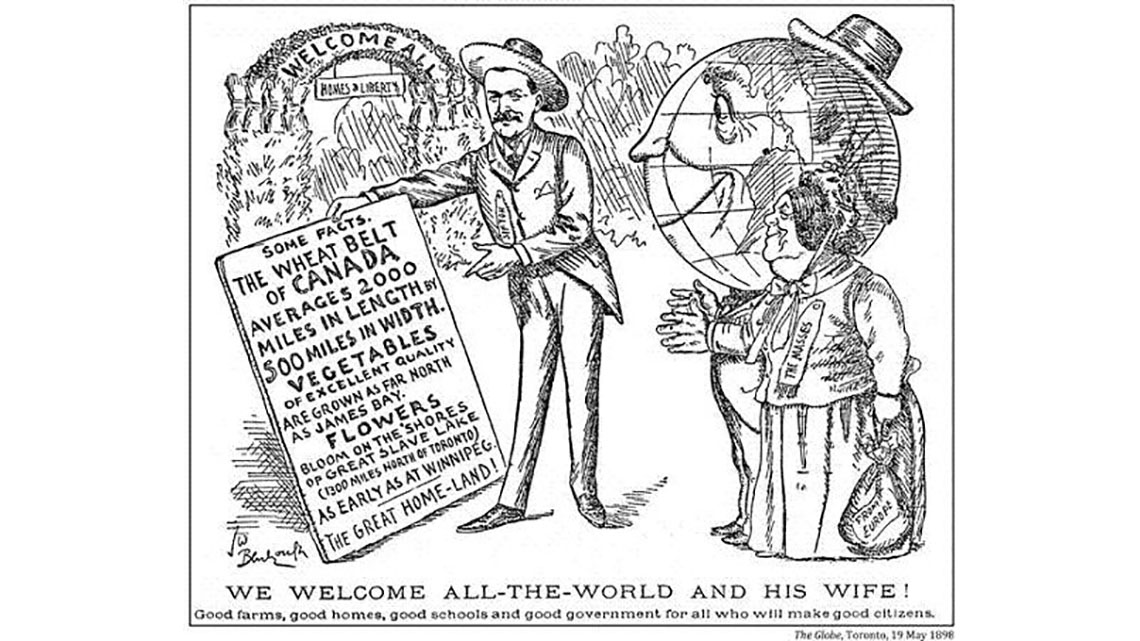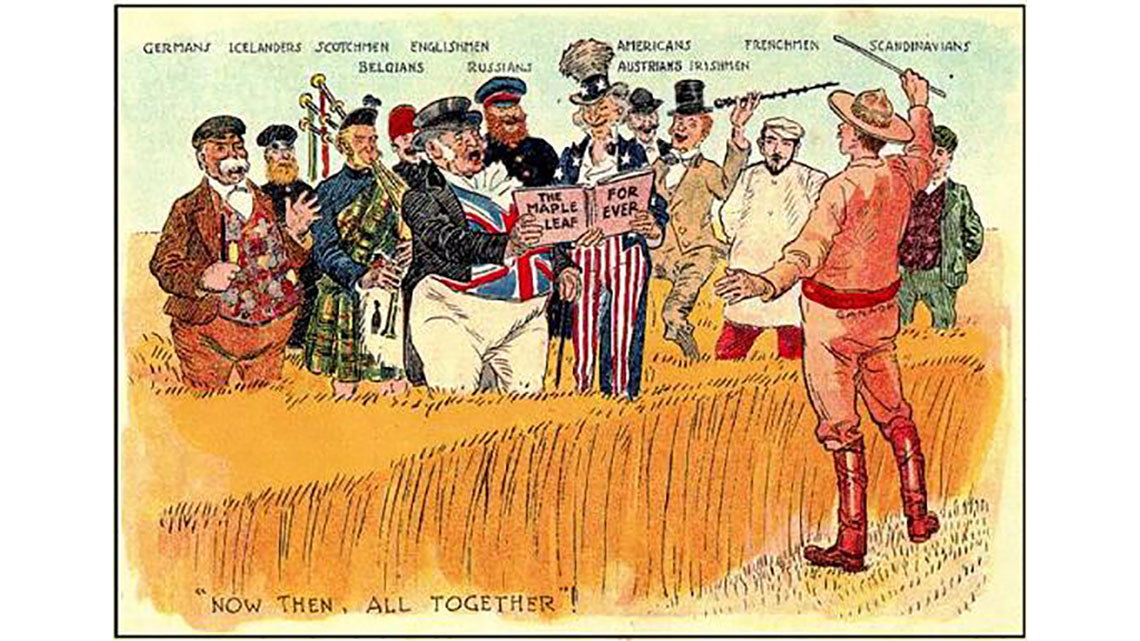Minds On
Task 1: Rising population
Examine the following population chart.
What do you notice about this population chart? What do you believe contributes to the rising population over time?

This is a population chart. It is labelled “Population (millions)” on the left y-axis and stats at 0 up to 40 in 5 million intervals. Along the bottom at the years 1850 to 2010 in 20 year increments. At 1850 the population is at 3 million. In 1870 it jumps to 4 million, and then 5 million in 1890. In 1910 the population jumps to approximately 7 million, and then to 11 million in 1930. In 1950 the population is at approximately 13 million, then a large jump to 21 million in 1970, to 27 million in 1990, and ends at approximately 36 million in 2010.
Task 2: Basic human rights

What are some basic human rights and services that all children and adults should be entitled to?
Brainstorm your ideas using a method of your choice. If possible, compare your list with someone else. What things did you both have on your list?
Action
Task 1: The push for immigration

Indigenous communities have lived on what we now call Canada since time immemorial. As time went on, colonizers from all over the world came to live in Canada, settling on traditional Indigenous territories. Many came because they wanted to. Many came to escape discrimination, hunger, or war. Canada offered a safe place to live and welcomed millions of immigrants, offering them freedom, democracy, and a new life. However, that doesn’t mean everyone who escaped to Canada was welcomed or treated the way they should have been.
As a result of immigration, diverse cultural, religious, and linguistic communities have established themselves in Canada, defining Canadian society as we know it today.
So, what does it mean to be a nation of immigrants? How has immigration changed over the years? How is it the same?
Begin by exploring the following video "Settling Historical Canada" as an introduction to immigration in Canada’s Western Provinces.
Clifford Sifton
Throughout the 1800s and 1900s, the government was desperate to grow the population of Canada, especially in the west. The government was specifically looking for new farming families to help develop agriculture.
Clifford Sifton was a successful Manitoba businessman, lawyer, and Cabinet member of the Manitoba government. Under Sir Wilfrid Laurier, Sifton was put at the forefront of Canada’s evolving immigration policy. Sifton began with a list of “preferred immigrants,” originally only wanting farmers to populate western Canada and add to the production of the country.
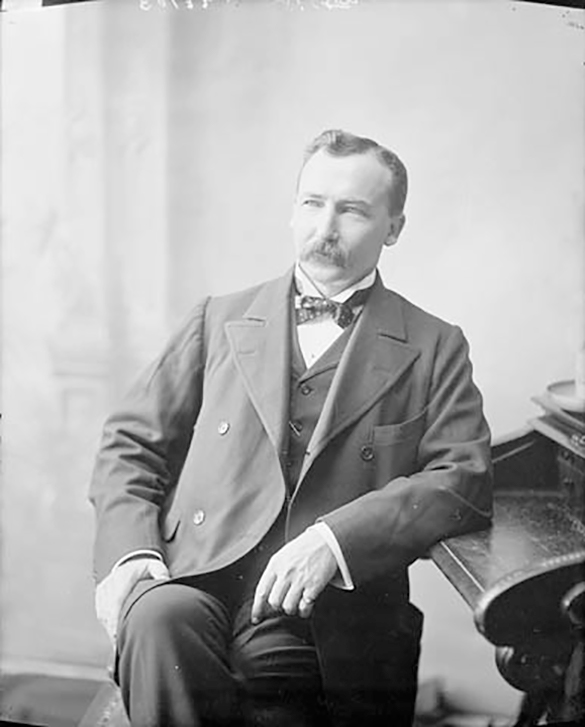
At the time, he believed only agriculturalists and peasants from Scotland, North of England, and Eastern and Central Europe were desirable immigrants. Sifton felt strongly that town dwellers, artisans, shopkeepers, and labourers were not desirable immigrants, as they didn’t make good pioneers and would increase the population of the major cities, adding to unemployment.
Sifton hired immigration agents to create advertisements in the form of posters and brochures to attract people to Canada’s advantage. They would often outline practical information such as transportation, soil, and climate, but leave out negative information, such as the cold winters in Canada. Sifton's widespread campaign was a huge success, and more than one million immigrants came to Canada between 1896 and 1905. About 40 percent of those immigrants came to the cities and the rest to rural areas, growing the population in rural areas from 300,000 to 1.5 million.
Examine the following poster that was created by Sifton to attract immigrants to Canada West.
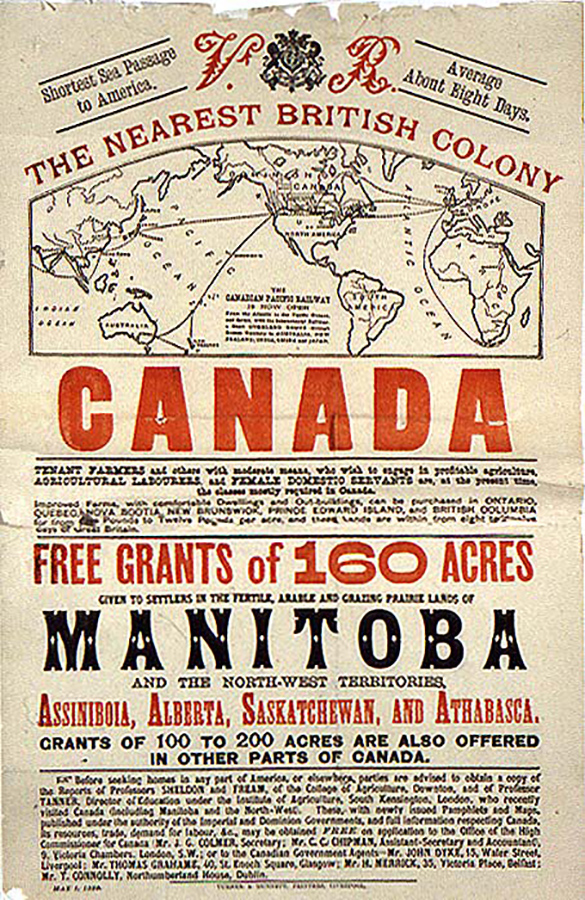
This is a poster that appeared in Britain in 1888 to attract immigrants to Canada. At the top of the poster on the left it says “Shortest Sea Passage to America” with the initials V.R. in the middle and then “Average About Eight Days” on the right. Below that it says “The Nearest British Colony” and it shows a map that details the route to Canada from surrounding areas. Below the map it says “CANADA” in big bold letters. There is more text between two lines below that, that is not legible. Below the bottom line it says “Free Grants of 160 Acres” in large writing, “given to settlers on the fertile … prairie lands of” in smaller writing, “MANITOBA” in large bold lettering, and then “and the northwest territories,” (in small lettering) “Assinboia, Alberta, Saskatchewan, and Athabasca. Lastly reads “grants of 100 to 200 acres of land are also offered in other parts of Canada” and then there is a paragraph of very small print that is not legible.
Source: Hall, 2008, CBC/Radio Canada, 2001
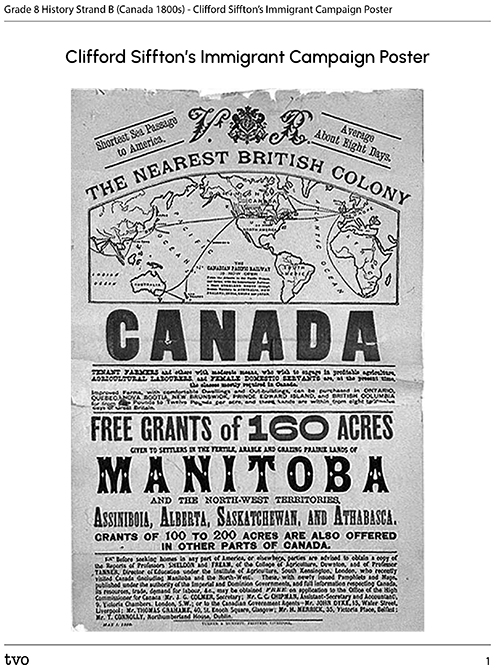
Press the Activity button to access the Clifford Sifton’s Immigrant Campaign Poster.
Activity(Opens in a new tab)Brainstorm
Reflect
Respond to the following questions based on the poster you just explored created by Clifton Sifton.
- Where do you think Sifton was mainly trying to attract settlers to? How do you know this?
- What is he offering new immigrants if they come to Canada?
- What can you infer the small print at the bottom might say?
Press the ‘Hint’ button if you would like help getting started with this question.
- What else did you notice that was interesting about this poster?
Press ‘Answer’ button to check you understanding.
- Sifton is trying to convince immigrants to settle on farmland, primarily in Manitoba. I know this because Manitoba is shown in the largest letters. Even though other areas of Canada are mentioned, the poster makes it clear that Manitoba is the primary place.
- Sifton is offering new immigrants areas of farmland, anywhere between 100-200 acres. In larger writing it specifically says 160 acres in Manitoba.
- I can infer that the small print might mention the legalities. For example, perhaps they will have to pay something eventually for the land if they do not farm enough, or there might be other criteria or stipulations immigrants need to meet before they’ll be welcome. Usually the fine print talks about the less desirable conditions or options.
- I also notice that the map would imply immigrants are coming from all over the world and that there is a big push for farmers only.
Rural immigration today
Similar immigration policies exist in Canada today. There is a push for new immigrants to settle in less populated, rural areas of the country. Explore one of the following options, the video or the article, about rural immigration in Canada.
You will now access the video entitled “Encouraging rural immigration.” (The term permanent residency is mentioned in the video. This means when someone is not a citizen of a country but has the right to live there on a permanent basis.)
You will now access the article “In Search of a More Peaceful Environment’: Newcomers Leave the GTA for New Homes Up North.”

Press tvo today to access "In Search of a More Peaceful Environment’: Newcomers Leave the GTA for New Homes Up North."
Opens in a new tabBrainstorm
Reflect
Respond to the following questions using a method of your choice.
- Why do you think there is a push for rural immigration?
- How is this push for immigration different?
Press the ‘Hint’ button if you need help getting started with this question.
Ukrainian settlement
The first two Ukrainians arrived in Alberta, Canada in 1891. Ukrainian immigrants preferred to settle amongst other Ukrainians and therefore the colony at Edna-Star, Alberta grew immensely. When Ukrainians first arrived in Canada, they faced many hardships. The size of land they were given (160 acres) was too large for them to establish a close-knit community, and those who could not make a living off the land often died. They received persecution from those who were already living in the Prairies, who discriminated against them because they spoke a different language and had different customs.
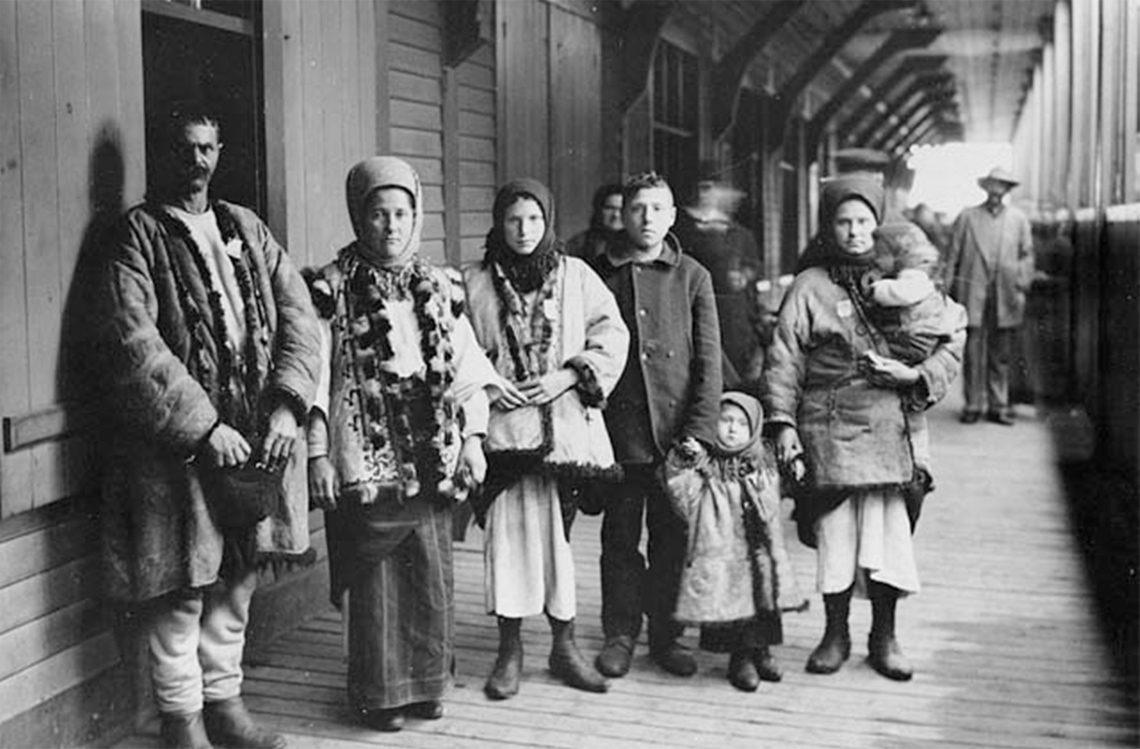
By 1914, a series of informal Ukrainian “blocs” of varying sizes crossed the three prairie provinces from southeastern Manitoba to just outside Alberta’s capital. Within this area, Ukrainians replicated and maintained their traditional way of living. However, this attitude of discrimination grew stronger with the outbreak of the First World War and Ukrainians became known as the enemy. Despite adversity, Ukrainians overcame discrimination and hardships presented before them with their positive attitudes, determinization to succeed, and strong work ethic.
Source: Swyrina, 2012, University of Manitoba Archives & Special Collections, 2005
Brainstorm
Reflect
What challenges did Ukrainian immigrants face on the Prairies at the end of the 19th century?
Press the ‘Answer’ button to check your understanding.
All People’s Mission
In the Minds On portion of this learning activity, you brainstormed basic services and human rights that all Canadians have access to if needed. For example, you may have brainstormed ideas like healthcare, education, access to food, and a pension plan. These services that Canadians rely on did not exist at the turn of the 20th century.
In the 1890s, Miss Dollie McGuire led a Sunday school for children. Some of the children she taught would come to school facing shortages of basic resources, such as food and clothing. Along with teaching the children, Miss McGuire began to provide families with basic resources that they desperately needed, such as adequate food and clothing. Eventually she moved her Church to Main Street in Winnipeg, where it was called the “All People’s Mission,” focused on helping and providing basic necessities for all people in the area.
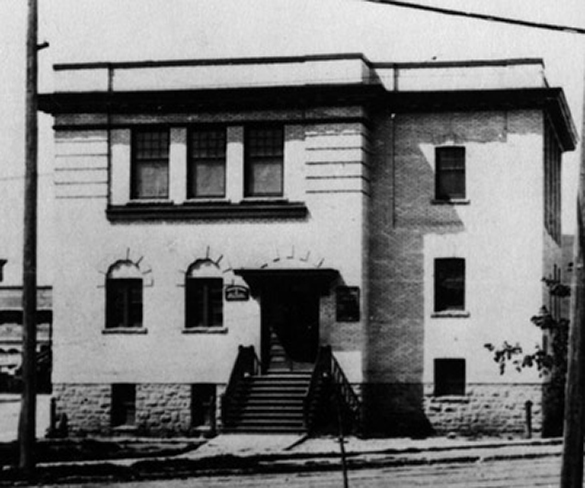
The All People’s Mission was aimed at addressing the needs of recently arrived immigrants. It was located near the railway station, which was where most of the immigrants arrived in Canada. In 1908, the All People’s Mission was renovated to include a basement and swimming tank and held assemblies and community gatherings. There were small spaces within the building dedicated to the Boys and Girls Club, teaching cooking, education, sewing, and reading.
In 1975, the All People’s Mission was purchased by the Manitoba Indian Brotherhood in conjunction with the Winnipeg Indian Council, and together they established the Manitoba Indigenous Cultural Centre (MICEC). To this day, the MICEC provides Winnipeg’s Indigenous and non-Indigenous communities with resources required to keep the province's First Nations languages, traditions, and teachings alive and flourishing!
Source: The Official Blog of Heritage Winnipeg, 2017

Modern version of the Manitoba Indigenous Cultural Centre in Winnipeg, 2015
This image is of a modern version of the Manitoba Indigenous Centre. It is a building which has three windows along the top. There are two more windows below them and another window area that extends beyond the building and people are standing in the window. There are seven large wooden poles. Each pole represents languages spoken by Indigenous people in Manitoba.
Brainstorm
Extend your learning
Extend your learning by researching modern-day programs designed to help newcomer immigrants who are settling in Canada.
Think about the following questions.
- What programs does Canada offer?
- Do you think they are enough?
- What do you feel we could do differently as a country to welcome newcomers to Canada?
Task 2: Policies & home children
Immigration Act
In 1910, the Canadian government established the Immigration Policy in order to gain control of the influx of people that were entering the country.
First, explore the list of definitions related to immigration. Then, explore the "Immigration Act of 1910 vs. Immigration Policy Today" document, which provides bullet point details about the Immigration Act of 1910, and the Immigration Policy today.
Review the following definitions related to this task.
The action of forcing someone to leave a country.
Someone or something that has been banned or forbidden.
A person’s legal resident status in a country or territory of which such person is not a citizen but where they have the right to reside on a permanent basis.
Examine the following printable Immigration Act of 1910 vs. Immigration Policy Today document.
|
Immigration policies 1885-1910 |
Immigration policy today |
|---|---|
|
In 1885, a duty of $50 was placed on any Chinese immigrant seeking to enter Canada, and then was increased to $100 in 1900, and to $500 in 1903. In 1906 the Immigration Act became more restrictive In 1908, a “Gentlemen’s Agreement” was made between the Canadian and Japanese governments to restrict Japanese immigration to Canada In 1910, the list of prohibited immigrants was expanded and prohibited anyone deemed “unsuited to the climate or requirements of Canada” Immigrants sponsored by charitable programs were prohibited Introduced the concept of permanent residency, which would be earned after living in Canada for three years Any immigrant who created public disorder would be subject to deportation The government could essentially deport anyone who defied the Immigration Act, even if they didn’t have solid proof; and lawyers or judges could not stop them All immigrants were required to have a minimum of $25 upon their arrival in Canada; and those from an Asiatic origin needed to have $200 |
In 2001, Canada replaced the Immigration Act with the Immigration and Refugee Protection Act Canada admits immigrants under one of four main categories: 1. Economic: immigrants come to Canada through highly-skilled worker programs 2. Family: immigrants come to Canada because they have family members (spouses, partners, children, etc.) already living in Canada 3. Protected Persons and Refugees: immigrants come to Canada when displaced from another country 4. Humanitarian / Other: there are a few other reasons someone is granted immigration, such as hardships and compassionate grounds Canada has temporary foreign-worker programs to address industry-specific needs and support the country economy Asylum seekers flee neighbouring countries to seek safety in Canada and are permitted |
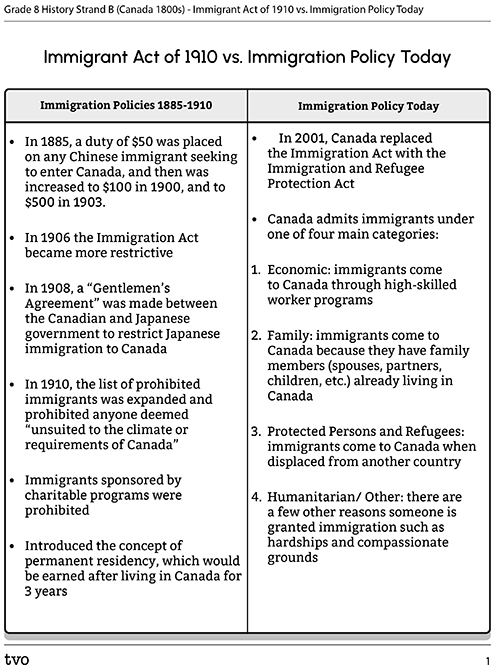
Press the Activity button to access the Immigration Act of 1910 vs. Immigration Policy Today.
Activity(Opens in a new tab)Brainstorm
Similarities and differences
What are some similarities and differences between the immigration policy today and between 1885 and 1910?
Record your ideas using the following fillable and printable Similarities and Differences Graphic Organizer or using a method of your choice.
|
Similarities |
Differences |
|---|---|
Press the ‘Activity’ button to access Similarities and Differences Graphic Organizer.
Press the “Answer’ button to check your responses.
|
Similarities |
Differences |
|---|---|
|
There are steps to earn permanent residency There are still (sometimes) specific criteria that need to be met to immigrate Canada still looks to immigration in order to fulfill economic demands or job opportunities People can still be deported |
Now called the Immigration and Refugee Protection Act All cultures and backgrounds are welcome in Canada today; there are no prohibited immigrants There is no minimal money amount needed to enter Canada is welcoming to refugees and asylum seekers People are not easily deported |
“Home children”
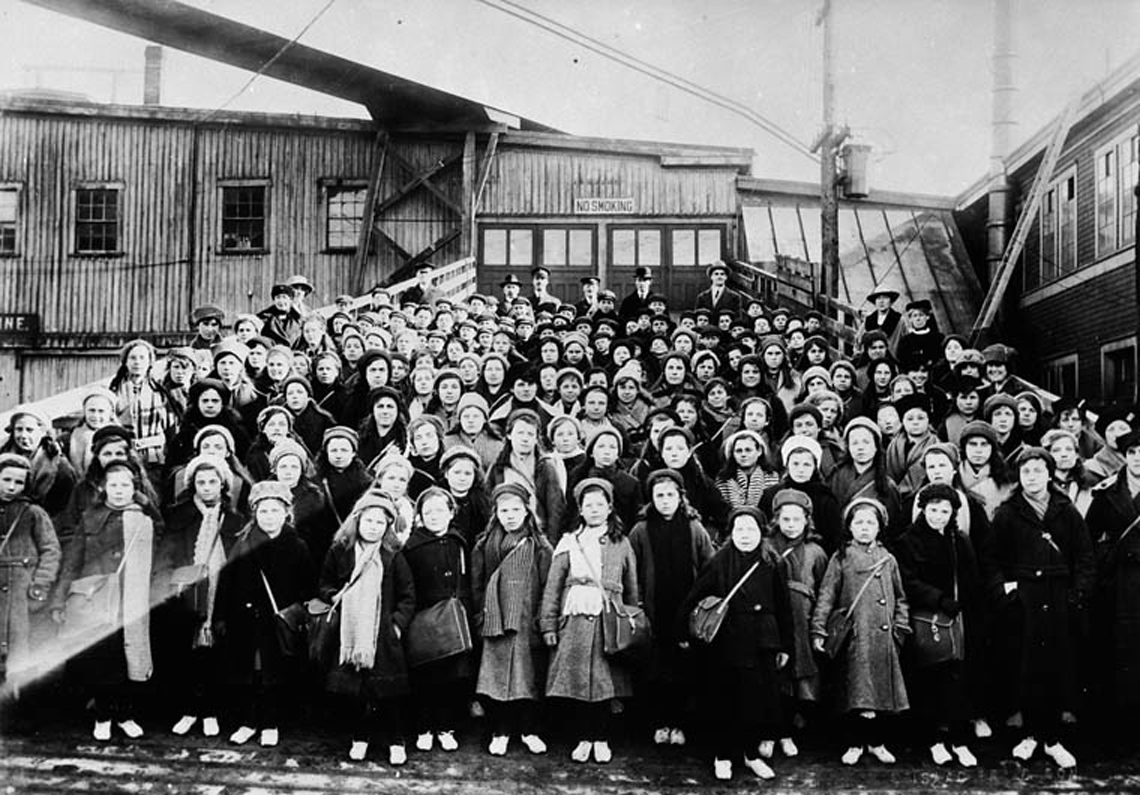
This image is of children coming from Britain arriving in St. John’s, New Brunswick. There are several rows of them standing side by side all wearing long jackets and have a cross body bag. There are a few adults at the back. Everyone is standing front of a large wood building with several windows and a sign that says “no smoking.”
Throughout the late 19th century, Britain was faced with poverty, pollution, and social inequality. As a result, thousands of people – including children – were forced to live in horrible conditions. Some children tried to work or lived on the streets. By the 1900s, it became impossible to ignore how bad the living conditions were for children in Britain, and organizations in both Britain and Canada decided they needed to do something about it. Even though the children were not orphans, their parents were not able to provide for them or keep them.
The plan was to have younger children adopted by Canadian families and have older children provided with food and shelter in exchange for farming help. Both countries supported the program. Britain did because it reduced the costs of having to support struggling children, and Canada did because it would provide “workers-in-training” and young children who could be adopted. They believed these children would have better opportunities and a chance for healthy and normal life in Canada. Countryside families agreed to send them to school and church on Sundays.
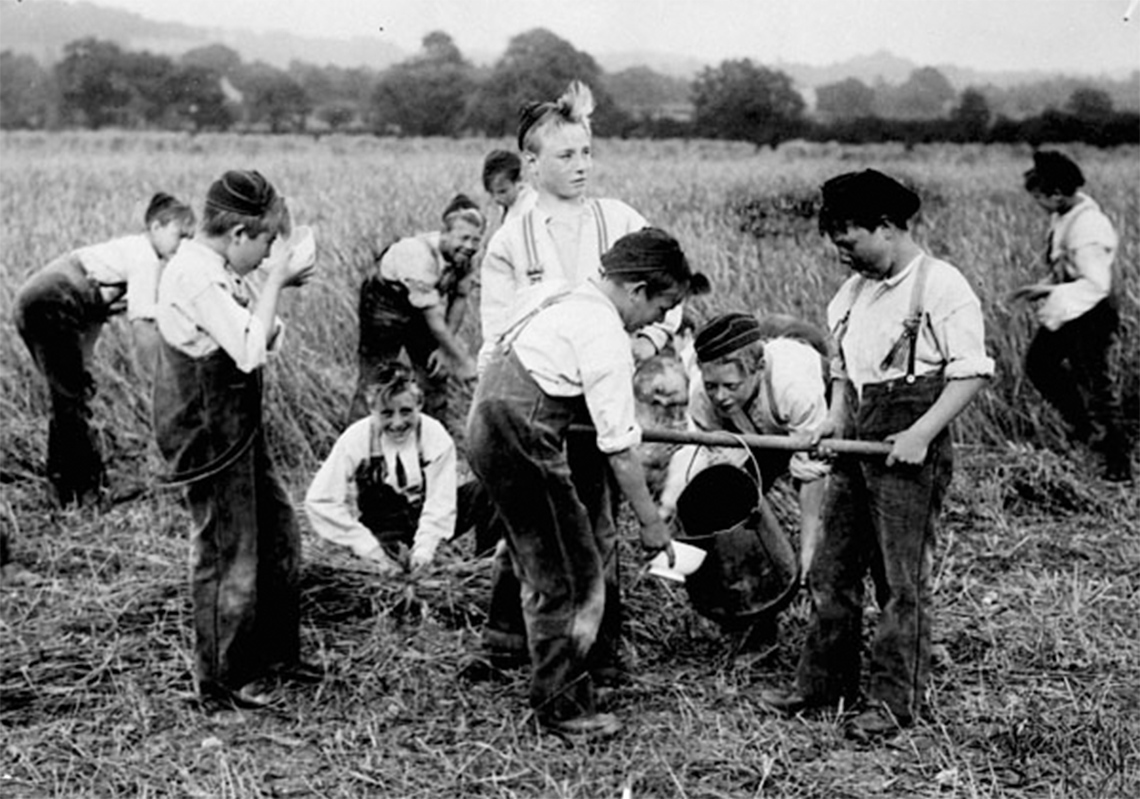
Young boys out in a field working. One of the boys are holding a piece of equipment and another is holding a bucket. They are all wearing overalls and a dress shirt. There are lots of trees in the background.
Between 1869 and 1948, over 100,000 children were sent to Canada. About 70 percent of those children were sent to Ontario. Others were sent to Quebec, Manitoba, the Maritime provinces and British Columbia. Living conditions varied for “home children.” Some were treated very well and found families that were very loving and caring. However, others were not. Many farming families saw the home children as free labour that could do the extra work while their other children were at school. Many home children did not get the opportunity to go to school and receive a good education.
In 2009 and 2010, the British and Australian premiers both issued a public apology to home children and met with former home children to hear their stories. Canada proclaimed 2010 the Year of the British Home Child and various efforts were made to ensure the past was not forgotten. Websites and organizers continue to try to gather information and help former home children trace their origins and ancestors.
Source: Canada’s History, 2010, Library and Archives Canada, 2021
Brainstorm
Reflect
Reflect on the following questions. Record your answers using a method of your choice.
- What factors contributed to immigration of home children?
- Do you think home children were better off in Canada than they were in Britain? Why or why not?
Press the “Hint’ button if you need some help getting started.
Task 3: Political cartoon analysis
What is a political cartoon?
A political cartoon is a cartoon about a political issue or event that is usually found in the newspaper. A political cartoon is intended to make you think about current events and sometimes sway your opinion towards another point of view.
In this task, you will explore two political cartoons created between 1898 and 1918. These are primary documents that represent attitudes towards immigration in Canada’s past.
Press ‘Primary Documents’ to access the definition for this term.
Brainstorm
Political cartoon analysis
Now that you have explored the two political cartoons, respond to the following questions about both cartoons using a method of your choice.
- What is the main idea/purpose of this political cartoon?
- What immigrant groups were encouraged to come to Canada and which were not?
- How did the government try to entice immigration to Western Canada?
Press ‘Possible Answers’ to check your understanding.
What immigrant groups were encouraged to come to Canada and which were not?
The government was looking for immigrants from specific countries, such as Germany, France, Scotland, or Iceland – primarily places in Europe. They were looking for people with money who would make “good citizens.”
How did the government try to entice immigration to Western Canada?
They tried to entice people to immigrate to Western Canada with the promise of land and the ability to grow vegetables. They also advertised flowers. They promise good farms, homes, schools, and government for all newcomers to Canada.
Task 4: Immigration inquiry
What is an inquiry?
An inquiry is a multi-step process used to formulate questions, gather, organize, and analyze information, evaluate and draw conclusions, and communicate results. Although the stages are not always done in the same order, the following graphic is from the Ontario Ministry of Education which provides a summary of these steps.
Examine the diagram to see how the steps relate.

A graphic representing the inquiry process. There are five stages to the inquiry process, but they are not always done in the same order. One stage is Interpret and Analyse. At this stage we analyse the data, evidence, and information, using different types of graphic organizers as appropriate. Another stage is Gather and Organize. At this stage we collect and organize relevant data, evidence, and/or information from primary and secondary sources and/or field studies. Another stage is Formulate Questions. At this stage, we formulate questions related to the applicable overall expectation in order to identify the focus of their inquiry. Another stage is Evaluate and Draw Conclusions. At this stage we synthesize data, evidence, and/or information, and make informed, critical judgements based on that data, evidence, and/or information. Another stage is Communicate. At this stage, we communicate judgements, decisions, conclusions, predictions, and/or plans of action clearly and logically.
So far in this learning activity you have learned about select experiences of immigrant groups who came to Canada between 1890 and 1914. Choose one of the following immigrant groups and research their experiences immigrating to Canada during this time.
Use the following checklist to help guide your research and record your findings in a method of your choice. Begin your research by exploring Canadian encyclopedias, virtual museums of immigration, and government websites.
- Chinese Immigrants (and the Head Tax)
- Irish Immigrants
- Ukrainian Immigrants
- Hungarian Immigrants
- French Immigrants
- Chinese Immigrants
- Romanian Immigrants
Checklist for Success
Consolidation
Task 1: Reflecting

What have you learned about Canadian immigration in the past and in the present? How are they similar and how are they different?
What type of immigration policies or regulations do you think Canada should have? Why?
Record your response using a method of your choice.
Task 2: Create a primary source
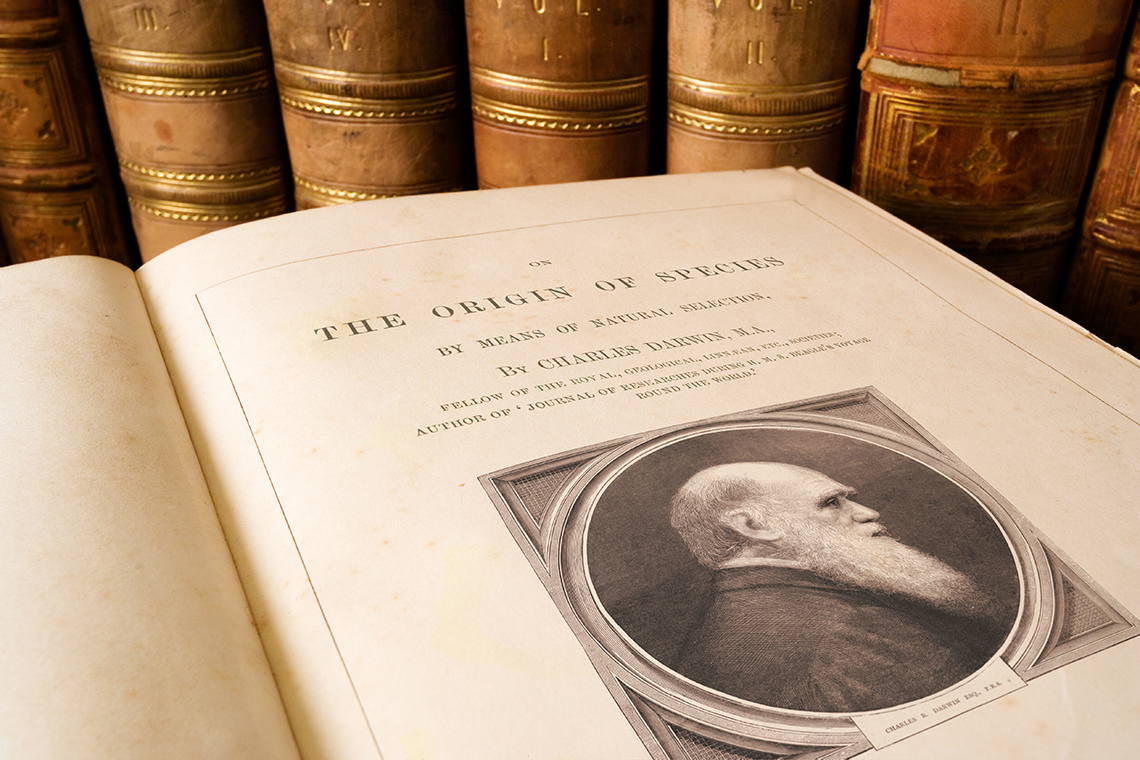
A primary source is an original material, regardless of format, that offers direct testimony or evidence about a historical topic. For this task, you will be creating a new primary source that captures the historical perspective of a time and place that you learned about in this learning activity.
Your task is to create a primary source related to immigration. You may choose to take on the perspective of someone who is immigrating to Canada or someone who already lives in Canada and describe their experience and perspective of immigration. The following list will help you decide what format you would like to create (consider what audience you will be sharing this with).
Format options
- Letter
- newspaper article
- political cartoon
- interview
- scrapbook
If you need help getting started, press the ‘Example’ button.
Reflection
As you read the following descriptions, select the one that best describes your current understanding of the learning in this activity. Press the corresponding button once you have made your choice.
I feel...
Now, expand on your ideas by recording your thoughts using a voice recorder, speech-to-text, or writing tool.
When you review your notes on this learning activity later, reflect on whether you would select a different description based on your further review of the material in this learning activity.
Press 'Discover More' to extend your skills.
Discover MoreConduct an interview with a family member about your ancestry.
You could ask them:
- What is our family’s immigration history?
- What are your views on immigration?
- What should future immigration policies to Canada include?
